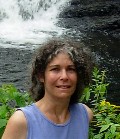Reading Our Region
Essays from a Regional Writer
 Susan Charkes enjoys hearing and telling stories, especially those involving the environment, farming, and sustainability in our region. Discover her poetic view of the outdoors and be inspired to visit the places she describes. Learn more about Susan, her writing, and even hear her podcasts at www.susancharkes.com.
Susan Charkes enjoys hearing and telling stories, especially those involving the environment, farming, and sustainability in our region. Discover her poetic view of the outdoors and be inspired to visit the places she describes. Learn more about Susan, her writing, and even hear her podcasts at www.susancharkes.com.
Sample these selected writings:
| Featured Items: |
Meadow and Woods at Bowman's Hill Wildflower Preserve
by Susan Charkes
On what’s billed as the hottest day of the year, there’s no better place to be than a shade- drenched grove of trees.
No, there’s no better place to be than a sun-saturated meadow.
How about both?
In Bowman’s Hill Wildflower Preserve in Solebury and Upper Makefield Townships, the black metal deer-exclusion fence at the entrance divides the yin and yang of summer: shade and sun. On one side is Penn’s Woods: a 15-acre, 60-year-old arboretum with a thousand trees, each planted in someone’s memory. On the other side is the Meadow: four hillside acres reclaimed from lawn, planted with native grasses and flowers. Gates in the fence allow people (but not deer) to pass back and forth.
From the Visitor Center parking lot, amble languorously (it’s hot, remember!) up the drive, to a sign marking the path into Penn’s Woods. We find not the deep shade of venerable forests, but the dappled shade of middle-aged woods. Shards of sun drop through holes in the canopy, pieces of the vast layer of heat above.
Signs along the level, graveled paths lead us to a gazebo. Seated here, look up to see mud dauber wasps decorating the ceiling with their organ-pipe nests. (Don’t worry – they won’t sting, unless you’re a spider.) A moment’s rest demonstrates the superiority of leafy shade over roofed shade. The gazebo traps hot air; trees cool it, using heat to evaporate water from leaf surfaces.
Beyond the gazebo, the path leads to the outbound driveway. The pushbutton-operated gate opens even more slowly than we can walk. Step into the Meadow. Here is a space sacred to sun-worshipers. Grasses and flowers climb higher, higher, higher, as if trying to get as close to their idol as possible. And midsummer is festival time for the sun’s pollinating acolytes.
At eye level are the butterfly weed, a bright orange native milkweed; the regally purple New York ironweed; swamp rose mallow, with dish-sized white blossoms; and crown-shaped monarda (bee-balm in crimson and bergamot in lavender). Blackberries on thorny canes ripen from green to red to ready-to-eat black. Lower down, like sea foaming at your knees, are swaths of tiny white flowers atop the mountain-mints.
In this riot of color, butterflies patterned in yellow, orange, white, and black flit from flower to flower, each unfurling a proboscis deep into the blossom to draw out nectar. A ruby-throated hummingbird zips by, stops, inserts bill into flower, drinks, zips away. Clearwing sphinx moths hover like hummingbirds but drink like butterflies; bumblebee-fuzzy and bumblebee-slow, they’re banded in green and red, with two-inch wide wings. All manner of bees are buzzing around the flowers too, along with their wasp cousins, and flies ranging from large beeflies to tiny jewel-like syrphids and almost invisible midges.
Well-fed, many of these nectar-lovers are fattening themselves for someone else’s benefit. The trees around the edge of the Meadow are laced with insect-hunting birds.
Even being a spectator at this pageant is exhausting after a while. Pollinators and meadow flowers revel in the sun; people wilt. So go back through the gate, across the fence line. After the heat and light and color and frenetic activity of the Meadow, the cool, quiet, monochromatic Woods, with its solid, reliable trees, is suddenly soothing.
But don’t leave without looking back.
(Entrance is on West side of River Road (Route 32), just south of Aquetong Road. The Preserve is open to the public but non-members pay a fee up to $5.)
© Susan Charkes 2006

